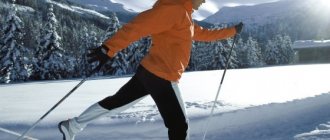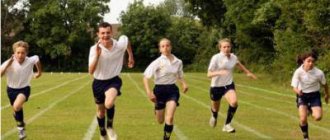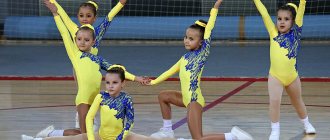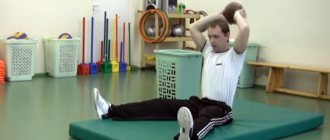Summer has come, but you are out of shape and want to get back into it quickly? Tired of barbecuing and weeding beds? The energy is overflowing, but you don’t know what to do? I've been wanting to take up sports for a long time, but couldn't decide which one? Then this article is for you.
Article on the topic Contraindications for fitness: who should not play sports
The Internet portal AiF.ru, as part of the “Sports in the City” project, has collected the ten best sports that you can start doing right now without any problems, in the city, outside the city, on vacation and even on the way to work.
How many sports are there in the world?
I will not give an example of all popular sports: according to surveys, there are more than 200,000,000 types and queues around the world (including all categories and subcategories). In addition, no one understands a huge number of disciplines.
New types appear almost monthly, so it is impossible to register them all, even for a global association. However, taking into account professional categories, we can highlight:
- Olympic - 52.
- Non-Olympic - 97.
- For people with disabilities.
Old Russian snowboard
Yes, yes, it seems that ancient Russian snowboarding existed in Rus'. In the “Notes on a Trade Trip to Moscow in 1584–1585” by the Dominican monk Martin Gruneweg, confessor of the well-known Marina Mnishek, there is a description of a strange sports equipment. It was called “arts” or “sledges” and, judging by the description of the design, resembled a modern “board”.
“Sometimes in the evening or when the moon is shining there [in the Kremlin moat] there is a crowd of several hundred people spending their free time. Instead of walking shoes, they tie to their feet an oak stick as thick as a thumb, as wide as a palm and 5 spans long, pointed and curved in front with a cord attached to it, which they hold in their hand, push the stick down the mountain, so that almost in an instant take off to a third of the other side. And no matter how dangerous this stupid addiction seems, nevertheless the Lord miraculously protects [from harm].”
Martin Groeneweg. “Notes on a trade trip to Moscow in 1584–1585”
Sports classification
Sports are divided into main groups. The first place in the number of disciplines is occupied by gaming competitions. The second place was taken by the classics: athletics, martial arts, artistic and rhythmic gymnastics. Thirdly, extreme sports are seriously gaining popularity.
In addition, specialized sports are common:
- car racing,
- a ride on the bicycle,
- shooting,
- skiing,
- swimming and much more.
The athletic department is based on characteristics common to all disciplines. Let's look at what sports exist in the world and how they differ:
- personal sports in which the participant participates (golf, billiards, tennis, chess, croquet, etc.);
- Repetitive: body movements using repetitive movements (biathlon, swimming, skating, kayaking, skiing, various types of athletics, etc.);
- team (game): a company of players takes part in competitions that usually compete with a similar company of competitors (football, hockey, handball, basketball, tug, etc.);
- strength: participants compete in exercises with special equipment (weightlifting, weightlifting, bodybuilding, weightlifting);
- martial arts: one athlete is superior to another in the influence of strength according to certain criteria (boxing, sambo, aikido, boxing at the end, belt fighting, hand-to-hand combat, etc.);
- comprehensive coordination: it is required that participants have special skills related to body control and coordination of movements (parkour, diving, skiing, acrobatics, rhythmic gymnastics, etc.);
- technical: competitions related to the implementation of the company’s technical advantages (bobsled track, shooting, speed track, ice skating, motorcycle, rally, etc.);
- applied: participants demonstrate a military or business plan (sport fishing, horse riding, sailing, orienteering, casting);
- extreme: competitions threaten the lives of participants (mountain climbing, diving, caves, sports tourism, winter swimming, etc.);
- aviation: introduction of aircraft (helicopters and gliders).
Yacht on skates
Yachtsmen also don’t want to get bored in winter. That's why they came up with the iceboat. This is a platform mounted on steel skates, with a rudder and a sail, almost like a yacht. Only sailing sleds move faster because there is no water resistance.
What you need : boat; ability to control a yacht.
Where to ride : on any frozen bodies of water. Entertainment is very popular in Poland and the part of Germany adjacent to the Baltic Sea. In Russia they race on Lake Baikal, on Lakes Senezhskoye and Onega, and on reservoirs in Karelia and the Far East.
Photo from baltictravelcompany.com
Characteristics of the main sports
Main sports:
- gymnastics,
- Athletics,
- skis,
- roller skating,
- swimming,
- rowing,
- a ride on the bicycle,
- weight lifting,
- struggle,
- boxing.
Gymnastics
All exercises are based on gymnastics. The purpose of the so-called basic gymnastics, which includes morning exercises and general exercises used by athletes of various specialties, is to maintain health and general physical development.
Sports or gymnastics, cross-gymnastics, barbells, rings and other equipment improve a person's motor skills. Movements are clear, soft, effective.
However, the presence of several breath-holding exercises can negatively affect the cardiovascular and respiratory systems; the gym is not combined with gymnastics and running, walking, skiing, skating, swimming.
Athletics
Athletics consists of walking, jogging, jumping and throwing the discus, chain and shot. These natural forms of movement work especially well together and can be widely used by beginners for exercise.
In adolescence and young adulthood, it is recommended to walk short distances (60 to 100 meters). After 40 years of age, performance declines, so it is recommended to do more weight-bearing exercises.
Sports exercises, which are carried out throughout the year in the fresh air, have a beneficial effect on the body: the nervous system, heart, lungs, blood. Therefore, these exercises are recommended for people who have health problems.
skiing
Skiing is one of the most popular and easily accessible forms of exercise. While riding, a major muscle group becomes active during work, breathing and circulation. The winter landscape has a positive effect on the nervous system. It's also quite easy to learn to ski.
Once you have mastered the movements, you can increase the distance evenly along the entire length of the course. The age range for skating is very wide. Skiing can be recommended for children from 5 to 6 years old. People begin to engage in professional ice sports at the age of 12.
Skating
Speed riding has a beneficial effect on the athlete's body. Ice skating is an effective form of active recreation for schoolchildren and the previous generation.
Movement on ice reduces the load on running, which allows you to use speed skating even with significant health problems. Fast skating can be recommended even in summer; it is important to gradually increase the load.
Swimming
The hygienic value of swimming is very high. Man has various influences here:
- effects of water on skin
- air procedures
- sunbathing
The difference in temperature at the time of entry and exit from the water affects the body’s adaptation to the temperature regime of the water source. Overcoming water resistance by developing active movements and breathing exercises.
The chest becomes convex, which produces a function suitable for the function of the lungs. The work of the heart during swimming due to difficulty breathing is much greater than in other sports.
Therefore, to avoid adverse effects on the cardiovascular system, you must first learn to breathe correctly, and only then perform speed swimming properly. Young children can specialize in swimming from 6 to 7 years of age. At the age of 12 they can begin to study professionally.
Rowing
Rowing is one of the most painful forms of exercise. All muscles of the body are involved: arms, legs, back, abdominal muscles. Because rowing requires good general physical fitness. Not recommended for people with cardiovascular problems.
You can start learning rowing from the age of 10, and specialize from the age of 14, while simultaneously increasing your workload and under the guidance of experienced teachers. In rowing, in addition to swimming, natural breathing exercises are an integral part of healing the body.
Rowing should be noted as an effective means of strengthening the abdominal muscles. Despite its intense workload, it can be practiced by older people, and quite often.
Cycling
Cycling has some features that make you very careful about this type of exercise. Prolonged position of a cyclist on a bicycle, footwork while the body is static are not entirely adequate criteria for blood circulation and breathing.
A cyclist, especially one who takes into account the need for comprehensive physical activity: regular exercises with general developmental gymnastics, running, and so on. Only in this version will cycling exercises provide the appropriate therapeutic effect.
Due to its excellent use when walking, it is recommended to increase the distance evenly without relieving symptoms of fatigue in the first few weeks.
Two-wheelers can be taught to children aged 8 to 9 years. At the age of 11-12 years you can afford to ride a bicycle for 30 - 40 minutes and for 13 - 14 years on cycling exercises.
Weight-lifting
Weightlifting is popular among the population due to the quick effects of exercise. In fact, lifting weights with a barbell or kettlebell perfectly develops the muscles of the body, arms and chest.
However, the effects on the nervous system, respiratory system and circulation with unilateral weightlifting grips can be negative as it is associated with respiratory arrest.
Success in this sport can only be achieved with long-term general physical training: gymnastic exercises in combination with other types of physical and sports exercises. And when you launch the barbell, it is advisable to include running, skiing, skating, etc.
This sport is allowed to people who do not have significant health problems from the age of 16.
Struggle
Wrestling is one of the oldest sports. There are many types of state battles. The most common is traditional or Greco-Roman wrestling.
The impact of various fights on the body is very great. Resistance to physical activity develops muscles well and actively affects internal organs. However, a one-sided commitment to intense combat with intense parts can lead to stagnation of the nervous and cardiovascular systems, such as weight lifting.
This requires careful preliminary work and combination with other physical activities such as athletics (running, skiing and walking). It is possible to specialize in wrestling at the age of 14, but the first 2 to 3 years of training should essentially be preparatory to general training and the study of technical and tactical techniques.
In middle and older age, only combat exercises begun at a young age can be continued. It is not recommended to start wrestling after 40 years of age, as this can negatively affect the cardiovascular system. box
Boxing
The box belongs to the so-called high-speed power sports. The combination of alternating movements of the arms, body and legs promotes good muscle development.
Boxers will, of course, use athletics in the process of preparing for the ring: running, throwing, jumping, general developmental gymnastics. The boxing match itself is filled with several situational moments that support reaction speed, agility, determination, endurance and other moral and volitional qualities.
With proper exercise control, boxing does not cause negative changes in health and perfectly tightens the body. Boxing exercises are allowed from the age of 13. From a laconic reassessment of the importance of the main sports, it is obvious that they are all good in themselves, and the result of physical exercise with them depends on the correct construction in the educational process in accordance with age, health, physical condition and regularity of physical exercise.
Only regular sports have a lasting effect on health, ensure success in sports and significantly improve athletic performance. Rating: 5/5 — 2 votes
Slideshow
What could be more relevant in winter than sledding down the mountain? Well, if there is neither a sled nor an ice cube, then any available items are used. At the end of the 20th century, schoolchildren rode down slides on cardboard and school bags. Even earlier, downhill racing had its own nuances.
“To my regret, my mother also did not allow me to participate in public skating, and... driving by, I looked with envy at the crowd of village boys and girls who, flushed from movement and cold, boldly flew from a high mountain, straight from the threshing floor, on small sleds, skates and ice cubes: the ice cubes were nothing more than old sieves or round popular prints, frosted from below just like the skates.”
Sergey Aksakov. "Childhood years of Bagrov's grandson"
S. Ivanov. Campaign of the Russian army, 16th century
Cyclic sports
The cyclical repetition of movements that move you in space is the essence of this sport. Speed plays a crucial role in defining the game.
- Ice skating
- Short track
- Cycling track
- Rock climbing (discipline - speed)
- Cycling highway
- Mountain bike (Mountain bike, cyclocross)
- Rowing
- Kayaking and canoeing
- Athletics (a number of events)
- Ski race
- Nordic combined (discipline - racing)
- Biathlon
- Swimming
- Diving
- Modern pentathlon (number of disciplines)
- Triathlon
- Karting
Taking the snow town
Today we are playing in the snow. Harmless fun. But someone always leaves the game with a black eye. Previously, they took a snowy town by storm. And this game was even less humane. Not only did they often defend and take the “fortress” with real clubs, but they also used cavalry.
Taking the snow town was a favorite pastime on Maslenitsa, and mostly men took part in it. Sometimes women helped: armed with brooms, branches and shovels, they defended the “fortress.”
The German traveler and ethnographer Johann Gmelin, who described the game in detail, said that serious passions were in full swing on the “battlefields”:
“... all the time they [the attackers] were met with clubs so much that even two of them fell from their horses and were soundly beaten. The horsemen became very furious because they could not take the fortress, and wanted to shoot arrows at the garrison, but the governor did not allow this, and the fortress remained in the possession of the previous owners.”
Technical sports
Technical sports are based on the interaction of an athlete with various technical equipment.
- Airplane simulation
- Automobile sport
- Jetski
- Bobsled
- Water skiing
- Karting
- Rally
- Rally Raid
- Rally cross
- Drag Racing
- Ship simulation
- Sprint Rally
- Drift
- Slalom
- ring championship
- Motorcycle trial
- Motorball
- Radiosport
- Rocket modeling sport
- Rafting
- Sled
- Skeleton
- Speedway
- Archery
- Crossbow shooting
- Bullet shooting
- Skeet shooting
History of arm wrestling
The very first mentions of arm wrestling were found during excavations of an Egyptian tomb dating back to approximately two thousand BC. On its walls there are depictions of people clasping their right hands and trying to pin their opponent’s hand to the table.
According to some reports, the Vikings also practiced hand-wrestling when they were tired of eating fly agarics and robbing their neighbors, and even the Slavs. It is also known that arm wrestling was widespread both under Ivan the Terrible and under Alexei Mikhailovich as a table sport for strong men, held at fairs and in taverns.
But as a sport, arm wrestling appeared in the USA. Moreover, it was known back in the 19th century under the general name “Indian wrestling”, which, in addition to the actual arm wrestling, included competitions of pulling each other’s hands and mutual kicking - whoever stood longer won.
By the way, there is also information about the so-called “hand sumo,” which appeared in Japan in 1928.
But let’s return to America, where on January 27, 1955, the first match in the so-called “wrestling”, that is, wrist wrestling, took place. The action took place in the Almaz bar in the California town of Petaluma, where the coach of the Detroit Tigers baseball team, Jack Gomel from San Francisco, and the owner of a ranch located near Petaluma, Oliver Kullberg, clashed.
Of course, everything did not happen right away. First, the enterprising journalist Bill Soberance, a regular at this bar, having heard Jack's tales that he would knock out any opponent in his arms and offers to challenge him to any armwrestler. As a result, Bill, along with bar owner Mike Gilardi, spread this challenge throughout the area and the rancher responded.
The fight between Jack and Oliver took place at a round table, where they fought while sitting. The struggle continued until the unfortunate table, unable to withstand the passions, fell apart in half. The judges were forced to declare a draw, but the organizers liked the reaction of the audience so much that the next year they held a whole championship, which attracted many participants.
Popularity grew, and in 1962 the first world arm wrestling championship was held. In 1968, artist Charles Schultz, author of the then famous comic strip “Peanuts,” published a magazine series in which he told the story of the dog Snoopy, who decided to become an arm wrestling champion and for this purpose went to Petaluma for the championship. But he was not allowed in because he did not have a big toe, and without it it is impossible to fight on his hands!
Since this comic book series was one of the most popular in the United States at that time, the fame of arm wrestling skyrocketed, and in 1969 a sixteen-year contract was signed with a television company, and arm wrestling began to be shown on television screens.
Compulsory Winter Olympic Sports
The list of sports in the IOC is constantly being updated. The basis for making adjustments is the popularity and dominance of the sport in the Olympic host country. After all, this is not the enthusiasm of advertisers of a particular discipline.
Here is a list of Winter Olympic sports currently included in the Olympic program:
- hockey;
- skiing (racing, biathlon, skiing, jumping, freestyle);
- biathlon;
- short track and speed skating;
- figure skating;
- sleds, sleds, skeletons;
- curling;
- snowboarding
This list will definitely be included in the future.
Disciplines:
➤
water polo;
➤
swimming;
➤
diving;
➤
synchronized swimming.
From the very beginning, only swimming in heats for various melts was approved, where 34 sets of awards are played out.
But water polo was added to the next Olympics, although this discipline remained a men's discipline until 2000. And diving was added to the next competition in 1904. With this trio of athletes, the athletes “swimmed” until 1984, when it became clear that the time had come to add beauty to strength and speed. And synchronized swimming “swimmed” into water sports. Volleyball
List of programs that you can learn on your own
At home you can:
- Practice yoga. To do this, you need video lessons with detailed descriptions of asanas.
- Learn the dance. Videos on the Internet will help with lesson developments. Go through them step by step in front of the mirror.
- Do push-ups and pull-ups. Suitable for men who want to strengthen their trapezius, deltoids, and arms.
- Run. If there is a park, stadium or forest near your home, then you can go jogging at any time.
John Brzenk and Sylvester Stallone - arm wrestling hits cinema screens
When talking about the history of arm wrestling, it is impossible not to mention the legend of this sport - John Brzenk, nicknamed “The Professor”. Born in 1964 into the family of a professional arm wrestler, John became interested in the sport quite early on. Yes, he became so interested that he tried to fight with his father’s friend and did not calculate his strength - his healthy father’s friend simply broke young John’s arm. But this did not dampen the enthusiasm of the future legend, and at the age of sixteen he took part in his first tournament.
John became a world champion at the age of eighteen, after which he won many prestigious professional tournaments. In 2014, “Professor” participated in a professional tournament in Moscow, where he became third in the open weight category, losing only to the Russian athlete Denis Tsyplenkov and the Ukrainian Andrey Pushkar. Despite the fact that at that time John was already fifty years old.
Still from the film “Fighting With All My Strength”
But one episode from the life of John Brzenk forever inscribed him in the history of arm wrestling from an unexpected angle. The fact is that the Americans decided to make a film about arm wrestling. But the first pancake turned out to be lumpy - the film PK & Kid, the main action of which takes place in Petaluma at an arm wrestling tournament, turned out to be such a slag that it was not even released.
But fortunately, Sylvester Stallone became interested in the idea, who, taking some of the plot twists of the previous film, together with several people, wrote the script for the film “Over The Top”, called “Fight and Forward” in our release.
The same John Brzenk was invited as a consultant, and to promote the film, an arm wrestling tournament of the same name was organized, where the main prize, as in the film, was a huge truck worth two hundred and fifty thousand dollars. And if in the film Stallone’s hero wins it, then in life it was the same “Professor” John Brzenk who took him. The film itself was shown in 1987, and it started a new wave of global popularity of arm wrestling.
Sultan Rakhmanov
In our country, the history of professional armwrestling begins in 1989, when a team of American and Canadian professionals came to the USSR, where fights took place between them and the strongest Soviet weightlifters, wrestlers and athletes. And naturally, almost all the fights were won by professional arm wrestlers, except for one - Sultan Rakhmanov, the Olympic champion in weightlifting in the super heavy category (150 kg), managed to defeat his opponent.
But since that time, arm wrestling in the territory of the former USSR, especially in Russia and Ukraine, has been developing at a frantic pace, and such top athletes as Denis Tsyplenkov or Andrey Pushkar are beginning to push the Americans off the pedestal.
Women's arm wrestling also began to gain momentum, and girls who wanted to prove that they too could have strong arms began to wrestle each other and sometimes men. Of course, a professional male arm wrestler is guaranteed to defeat an equally professional female, but with a non-professional male it can be different.











